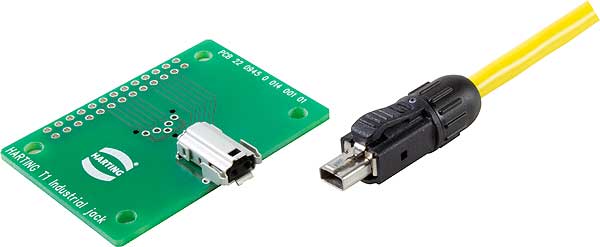 The Industrial Internet of Things (IIoT) is growing at a rapid pace. Experts agree that Single Pair Ethernet (SPE) will be one of the key technologies that will significantly shape the success of the IIoT. The factory of the future needs high data streams – and for this, the industrial sector needs connectivity which adapts itself to increasingly growing demands. This is most effectively achieved through standards that market players develop and advance through partnerships in an open eco-system.
The Industrial Internet of Things (IIoT) is growing at a rapid pace. Experts agree that Single Pair Ethernet (SPE) will be one of the key technologies that will significantly shape the success of the IIoT. The factory of the future needs high data streams – and for this, the industrial sector needs connectivity which adapts itself to increasingly growing demands. This is most effectively achieved through standards that market players develop and advance through partnerships in an open eco-system.
HARTING has recognised the requirements of the factory of the future. At the HANNOVER MESSE trade show, the technology group presents intelligent connectivity with solution packages for the Cloud, Edge and IIoT under the name HAI³ powered Connectivity!
How successful solutions and products in the field of SPE can be put into practice will be demonstrated by HARTING at HANNOVER MESSE together with its Japanese partner HIROSE. In addition, HARTING will use the show to announce its collaboration with TE Connectivity. Both companies are eager to work together more closely in the field of SPE infrastructure in the future.
HARTING presents first series products at the HANNOVER MESSE
HARTING has long been driving the development of Ethernet connectivity for tomorrow’s networks. The technology group supplies the matching standardized interfaces and will be showing first series products at the HANNOVER MESSE 2019.
As an enabler of IIoT, HARTING is thus taking the step from a technology trend to a real application and customer solution. With an interface standardized according to IEC 63171-6, the technology group is consistently following the path: recognizing trends, defining standards and delivering high-quality products. Hall 11 (Booth C15) will feature the first IP20 interface of connectors and angled PCB socket.
But what’s actually behind Single Pair Ethernet? Generations of network engineers, planners, installers and users have learned that Fast Ethernet 10/100Mbps requires cabling with two wire pairs and Gigabit Ethernet requires four wire pairs. The new Single Pair Ethernet is now pushing a technology into the market that can transmit these TCP/IP-based data streams via just one pair of wires.
This technique, which is being driven by the automotive industry, is increasingly gaining importance in automation technology, where it is being further developed in targeted manner. Due to its simplicity and the associated reduction in weight, space requirements and installation effort, this technology is hailed as having a great future within industry, automation technology and the rail industry, among others.
SPE now also makes it possible to bring digitisation, i. e. continuous IP-based communication, to the field level. Equipping simple sensors or cameras, reading and identification devices, etc. with Ethernet interfaces supports the implementation of Integrated Industry and IIoT. No more different protocols, no unnecessary delays due to translation, and even real-time capability with TSN. IP-based communication from the Cloud down to each and every sensor has long been a sought-after vision that now takes on very real forms.
Consistent compatibility of devices, cables and connectors
A prerequisite for the widespread use and thus the successful marketing of SPE technology is the end-to-end compatibility of devices, cables and connectors. Since the beginning of the year, an ISO/IEC international selection process has been in progress for cabling and the selection of standardised SPE mating faces, involving more than 20 national expert committees. As a result of this selection, two mating faces have prevailed:
- for building wiring, the mating face according to IEC 63171-1: this mating face is based on the proposal by CommScope
- for industrial and industry applications, the mating face IEC 63171-6: this mating face is based on the proposal by HARTING.
The core element of this new HARTING T1 industrial connector family is an always-uniform SPE mating face that is used for all versions from IP20 up to IP65/67. HARTING has aligned its connector design accordingly and can achieve both 1GBit/s for shorter distances and 10Mbit/s for long distances with a mutually compatible mating face.
HARTING Technology | www.HARTING.com


